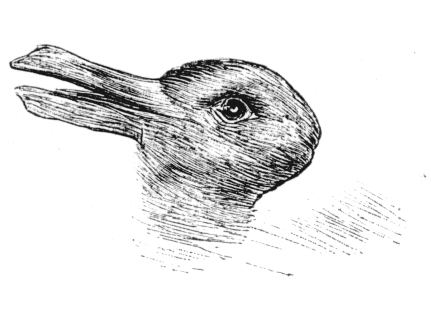Hack31.Minimize Imaginary Distances
|
Hack 31. Minimize Imaginary Distances
If you imagine an inner space, the movements you make in it take up time according to how large they are. Reducing the imaginary distances involved makes manipulating mental objects easier and quicker. Mental imagery requires the same brain regions that are used to represent real sensations. If you ask someone to imagine hearing the first lines to the song "Purple Haze" by Jimi Hendrix, the activity in her auditory cortex increases. If you ask someone to imagine what the inside of a teapot looks like, his visual cortex works harder. If you put a schizophrenic who is hearing voices into a brain scanner, when she hears voices, the parts of the brain that represent language sounds really are activeshe's not lying; she really is hearing voices. Any of us can hear voices or see imaginary objects at will; it's only when we lose the ability to suppress the imaginings that we think of it as a problem. When we imagine objects and places, this imagining creates mental space that is constrained in many of the ways real space is constrained. Although you can imagine impossible movements like your feet lifting up and your body rotating until your head floats inches above the floor, these movements take time to imagine and the amount of time is affected by how large they are. 2.20.1. In ActionIs the left shape in Figure 2-28 the same as the right shape? Figure 2-28. Is the left shape the same as the right shape? How about the left shape in Figure 2-29is it the same as the right shape? Figure 2-29. Is the left shape the same as the right shape? And is the left shape in Figure 2-30 the same as the one on the right? Figure 2-30. Is the left shape the same as the right shape? To answer these questions, you've had to mentally rotate one of each pair of the shapes. The first one isn't too hardthe right shape is the same as the left but rotated 50°. The second pair is not the same; the right shape is the mirror inverse of the left and again rotated by 50°. The third pair is identical, but this time the right shape has been rotated by 150°. To match the right shape in the third example to the left shape, you have to mentally rotate 100° further than to match the first two examples. It should have taken you extra seconds to do this. If you'd like try an online version, see the demonstration at http://www.uwm.edu/People/johnchay/mrp.htm (requires Shockwave). When we tried it, the long version didn't save our data (although it claimed it did) so don't get excited about being able to analyze your results; at the moment, you can use it only to get a feel for how the experiment works. 2.20.2. How It WorksThese shapes are similar to the ones used by Robert Shepard and Jacqueline Metzler1 in their seminal experiments on mentally rotation. They found that the time to make a decision about the shapes was linearly related to the angle of rotation. Other studies have shown the mental actions almost always take up an amount of time that is linearly related to the amount of imaginary movement required. This shows that mental images are analog representations of the real thingwe don't just store them in our head in some kind of abstract code. Also interesting is the fact that mental motions take up a linearly increasing amount of time as mental distance increases; in the original experiments by Shepard and Metzler, it was one extra second for every extra 50°. This relationship implies that the mental velocity of our movements is constant (unlike our actual movements, which tend to accelerate sharply at the beginning and decelerate sharply at the end, meaning that longer movements have higher velocities). Further studies of mental rotation2 showed that the mental image does indeed move through all the transitional points as it is rotated in and that at least in some experiments, rotating complex shapes didn't take any longer than rotating simple shapes. Other experiments3 have also shown that moving your mind's eye over a mental space (such as an imagined map) takes time that is linearly related to the imagined distance. If you "zoom in" on a mental image, that takes time as well. So if you ask people to imagine an elephant next to a rabbit, they will take longer to answer a question about the color of the rabbit's eyes than about the color of the elephant's eyes. You can partially avoid this zooming-in time by getting people to imagine the thing really large to start withasking them to start, say, by imagining a fly and then the rabbit next to it. Recent neuroimaging research4 has shown that mentally rotating objects may involve different brain regions from mentally rotating your own body through space. Studies that compare the difficulty of the two have found that it is easier and faster to imagine yourself mental rotating around a display of objects than it is to imagine the objects rotating around their own centers.5 So if you are looking at a pair of scissors that have the handle pointing away from you, it will be easier to imagine yourself rotating around the scissors in order to figure out if they are lefthanded or righthanded scissors, rather than imaging the scissors rotating around so that the handle faces you. And easiest of all is probably to imagine just your own hand rotating to match the way the handle is facing. All this evidence suggests that mental space exists in analog form in our minds. It's not just statements about the thing, but a map of the thing in your mind's eye. There is some evidence, however, that the copy in your mind's eye isn't an exact copy of the visual inputor at least that it can't be used in exactly the same way as visual input can be. Look at Figure 2-31, which shows an ambiguous figure that could be a duck or could be a rabbit. You'll see one of them immediately, and if you wait a few seconds, you'll spot the other one as well. You can't see both at once; you have to flip between them and there will always be one you saw first (and which one you see first is the sort of thing you can affect by priming [Hack #81], exposing people to concepts that influence their later behavior). Figure 2-31. You can see this picture as a duck or a rabbit, but if you'd seen only one interpretation at the time, could you see the other interpretation in your mind's eye?7 If you flash a figure up to people for just long enough for them to see it and make one interpretationto see a duck or a rabbit, but not boththen they can't flip their mental image in their mind's eye to see the other interpretation. If they say they saw a duck, then if you ask them if the duck could be a rabbit, they just think you're mad.6 Perceiving the ambiguity seems to require real visual input to operate on. Although you have the details of the image in your mind's eye it seems you need to experience them anew, to refresh the visual information, to be able to make a reinterpretation of the ambiguous figure. 2.20.3. In Real LifeWe use mental imagery to reason about objects before we move them or before we move around them. Map reading involves a whole load of mental rotation, as does fitting together things like models or flat-pack furniture. Assembly instructions that involve rotating the object will be harder to compute, all other things being equal. But if you can imagine the object staying in the same place with you rotating around it, you can partially compensate for this. The easier it is to use mental rotation, the less physical work we actually have to do and the more likely we are to get things right the first time. 2.20.4. End Notes
2.20.5. See Also
|
|
EAN: N/A
Pages: 159